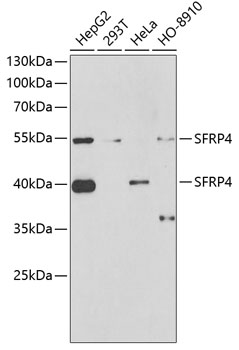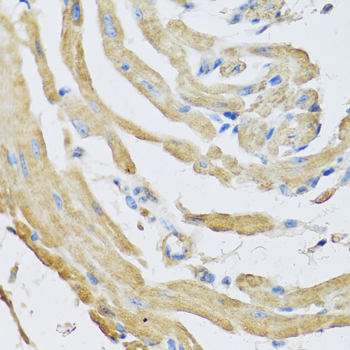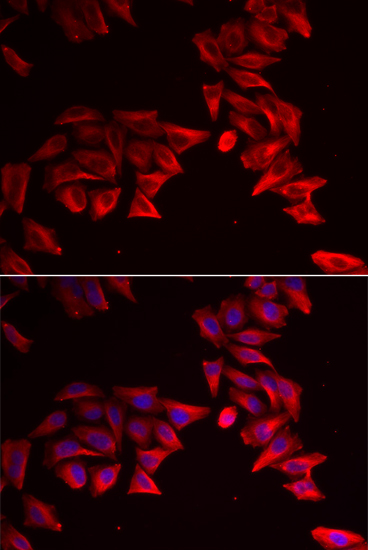-
Product Name
SFRP4 Polyclonal Antibody
- Documents
-
Description
Polyclonal antibody to SFRP4
-
Tested applications
WB, IHC, IF
-
Species reactivity
Human, Mouse, Rat
-
Alternative names
SFRP4 antibody; FRP-4 antibody; FRPHE antibody; PYL antibody; sFRP-4 antibody; secreted frizzled-related protein 4 antibody
-
Isotype
Rabbit IgG
-
Preparation
Antigen: Recombinant fusion protein containing a sequence corresponding to amino acids 19-346 of human SFRP4 (NP_003005.2).
-
Clonality
Polyclonal
-
Formulation
PBS with 0.02% sodium azide, 50% glycerol, pH7.3.
-
Storage instructions
Store at -20℃. Avoid freeze / thaw cycles.
-
Applications
WB 1:500 - 1:2000
IHC 1:50 - 1:100
IF 1:50 - 1:100 -
Validations

Western blot - SFRP4 Polyclonal Antibody
Western blot analysis of extracts of various cell lines, using SFRP4 antibody at 1:1000 dilution.Secondary antibody: HRP Goat Anti-Rabbit IgG (H+L) at 1:10000 dilution.Lysates/proteins: 25ug per lane.Blocking buffer: 3% nonfat dry milk in TBST.Detection: ECL Basic Kit .Exposure time: 60s.

Immunohistochemistry - SFRP4 Polyclonal Antibody
Immunohistochemistry of paraffin-embedded mouse heart using SFRP4 antibody at dilution of 1:100 (40x lens).

Immunofluorescence - SFRP4 Polyclonal Antibody
Immunofluorescence analysis of HeLa cells using SFRP4 antibody . Blue: DAPI for nuclear staining.
-
Background
Soluble frizzled-related proteins (sFRPS) function as modulators of Wnt signaling through direct interaction with Wnts. They have a role in regulating cell growth and differentiation in specific cell types (By similarity). SFRP4 plays a role in bone morphogenesis. May also act as a regulator of adult uterine morphology and function. May also increase apoptosis during ovulation possibly through modulation of FZ1/FZ4/WNT4 signaling (By similarity). Has phosphaturic effects by specifically inhibiting sodium-dependent phosphate uptake.
Related Products / Services
Please note: All products are "FOR RESEARCH USE ONLY AND ARE NOT INTENDED FOR DIAGNOSTIC OR THERAPEUTIC USE"
